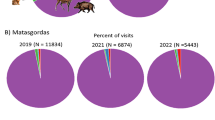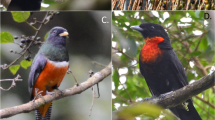Summary
Interactions between a large community of vertebrate frugivore-granivores (including 7 species of large canopy birds, 19 species of rodents, 7 species of ruminants, and 6 species of monkeys), and 122 fruit species they consume, were studied for a year in a tropical rainforest in Gabon.
The results show how morphological characters of fruits are involved in the choice and partitioning of the available fruit spectrum among consumer taxa. Despite an outstanding lack of specificity between fruit and consumer species, consideration of simple morphological traits of fruits reveals broad character syndromes associated with different consumer taxa. Competition between distantly related taxa that feed at the same height is far more important than has been previously supposed. The results also suggest how fruit characters could have evolved under consumer pressure as a result of consumer roles as dispersers or seed predators. Our analyses of dispersal syndromes show that fruit species partitioning occurs more between mammal taxa than between mammals and birds. There is thus a bird-monkey syndrome and a ruminant-rodent-elephant syndrome. The bird-monkey syndrome includes fruit species on which there is no pre-dispersal seed predation. These fruits (berries and drupes) are brightly colored, have a succulent pulp or arillate seeds, and no protective seed cover. The ruminant-rodent-elephant syndrome includes species for which there is pre-dispersal predation. These fruits (all drupes) are large, dull-colored, and have a dry fibrous flesh and well-protected seeds.
Similar content being viewed by others
References
Alexandre DY (1978) Le rôle disséminateur des éléphants en forêt de Tai, C.I. Terre et Vie 32:47–72
Benzecri J-P (1973) L'analyse des données. T.2: L'analyse des correspondances. Paris, Dunod
Bonaccorso FJ, Glanz WE, Sandford CM (1980) Feeding assemblages of mammals at fruiting Dipteryx panamensis (Papilionaceae) trees in Panama: seed predation, dispersal, and parasitism. Rev Biol Trop 28:61–72
Charles-Dominique P, Atramentowicz M, Charles-Dominique M, Gérard H, Hladik A, Hladik CM, Prevost MF (1981) Les mammiféres frugivores arboricoles nocturnes d'une forêt guyanaise: interrelations plantes-animaux. Rev Ecol (Terre Vie) 35:341–435
Cooper HM, Charles-Dominique P, Vienot F (in press) Signification de la coloration des fruits en fonction de la vision des vertébrés consommateurs. Ent Museum
Corner EJH (1949) The Durian theory or the origin of the modern tree. Ann Bot 13:317–414
Denslow JS, Moermond TC (1982) The effect of accessibility on rates of fruit removal from tropical shrubs: an experimental study. Oecologia 54:170–176
Diamond JM (1973) Distributional ecology of New Guinea birds. Science 179:759–769
Dubost G (in press) Comparison of the diets of frugivorous forest ruminants of Gabon. J Mammal
Duplantier JM (1982) Les rongerours myomorphes forestiers du N-E Gabon. Thèse 3o cycle, Univ Montpellier, pp 129
Emmons L (1981) Ecology and ressource partitioning among nine species of African rain forest squirrels. Ecol Monogr 50:31–54
Emmons L (1983) A field study of the African brush-tailed porcupine, Atherurus africanus by radiotelemetry. Mammalia 47:183–194
Emmons LH, Gautier-Hion A, Dubost G (1983) Community structure of the frugivorous-folivorous forest mammals of Gabon. J Zool Lond 199:209–222
Fenelon J-P (1981) Qu'est-ce que l'analyse de données. Paris, Lefonen
Fleming TH (1979) Do tropical frugivores compete for food? Amer Zool 19:1157–1172
Fleming TH, Heithaus ER (1981) Frugivorous bats, seed shadows and the structure of tropical forests. Reprod Botan 45:83–87
Florence J, Hladik A (1980) Catalogue des Phanérogames et des Ptéridophytes du N-E du Gabon (6° liste). Adansonia 20:235–253
Bautier-Hion A (1971) L'écologie du talapoin du Gabon (Miopithecus talapoin). Terre et Vie 4:427–490
Gautier-Hion A (1977) Données sur le régime alimentaire de Cercocebus albigena dans le N-E Gabon. Terre et Vie 31:579–585
Gautier-Gion A (1978) Food niche and coexistence in sympatric primates in Gabon. In: Chivers DJ, Herbert J (eds) Recent advances in primatology. Acad Press, New York, London, pp 269–286
Gautier-Hion A (1980) Seasonal variations of diet related to species and sex in a community of Cerconithecus monkeys. J An Ecol 49:237–269
Gautier-Hion A (1984) La dissémination des graines par les cercopithecidés forestiers africains. Rev Ecol (Terre Vie) 39:159–165
Gautier-Hion A, Emmons LH, Dubost G (1980) A comparison of the diets of three major groups of primary consumers of Gabon. Oecologia 45:182–189
Hallé N (1964) Première liste de phanérogames et de Pteridophytes des environs de Makokou, Mekambo et Belinga. Biol Gabon 1:41–46
Hallé N (1965) Seconde liste de Phanérogames et de Ptéridophytes du N-E Gabon (Makokou, Belinga, Mekambo). Biol Gabon 1:337–344
Hallé N (1974) Attractivité visuelle des fruits pour les animaux. J Psychol Nor Path 4:389–407
Hallé N, Le Thomas A (1967) Troisième liste des Phanérogames du N-E Gabon. Biol Gabon 3:113–120
Hallé N, Le Thomas A (1970) Quatrième liste de Phanérogames et Pteridophytes du N-E Gabon. Biol Gabon 6:131–138
Hallé N, Le Thomas A, Gazel M (1967) Trois relevés botaniques dans les forêts de Belinga (N-E Gabon). Biol Gabon 3:43–58
Harrison JL (1962) The distribution of feeding habits among animals in a tropical rain forest. J An Ecol 31:53–63
Herrera CM (1981 a) Are tropical fruits more rewarding to dispersers than temperate ones? Am Nat 118:896–907
Herrera CM (1981 b) Fruit variation and competition for dispersers in natural populations of Smilax aspera. Oikos 36:51–58
Herrera CM (1982) Seasonal variations in the quality of fruits and diffuse coevolution between plants and avian dispersers. Ecology 63:773–785
Hladik A, Hallé N (1973) Catalogue des Phanérogames du N-E Gabon (5° liste) Adansonia 13:527–544
Hladik A, Hladik CM (1969) Rapports trophiques entre végétation et primates dans la forêt de Barro Colorado. Terre et Vie 1:25–117
Hladik CM (1981) Diet and the evolution of feeding strategies among forest primates. In: Harding RSO, Teleki G (eds). Omnivorous Primates: gathering and hunting in human evolution. Columbia Univ Press, New York, pp 215–254
Hladik CM, Hladik A (1967) Observations sur le rôle des primates dans la dissémination des végétaux de la forêt gabonaise. Biol Gabon 3:43–58
Howe HF (1977) Bird activity and seed dispersal of a tropical wet forest tree. Ecology 58:539–550
Howe HF (1979) Fear and frugivory. Am Nat 114:925–931
Howe HF (1980) Monkey dispersal and waste of a neotropical fruit. Ecology 6:944–959
Howe HF, Estabrook GF (1977) On interspecific competition for avian dispersers in tropical trees. Am Nat 111:817–832
Howe HF, Vande Kerckhove GA (1979) Fecundity and seed dispersal of a tropical tree. Ecology 60:180–189
Howe HF, Vande Kerckhove GA (1981) Removal of wild nutmeg (Virola surinamensis) crops by birds. Ecology 62:1093–1106
Howe HF, Smallwood J (1982) Ecology of seed dispersal. Ann Rev Ecol Syst 13:201–228
Jacobs GH (1978) Spectral sensitivity and colour vision in the ground-dwelling sciurids: results from golden mantled ground squirrels and comparisons for five species. Anim Behav 26:409–421
Janson CH (1983) Adaptation of fruit morphology to dispersal agents in a Neotropical forest. Science 219:187–189
Janzen DH (1969) Seed-eaters versus seed size, number, toxicity and dispersal. Evolution 23:1–27
Janzen DH (1971) Seed predation by animals. Ann Rev Ecol Syst 2:465–492
Janzen DH (1977) Promising directions of study in tropical animal-plant interactions. Ann Miss Bot gard 64:706–736
Janzen DH (1978) Seeding patterns of tropical trees. In: Tomlinson PB, Zimmermann MH (eds) Tropical trees as living systems. Cambridge Univ Press, Cambridge, pp 83–128
Janzen DH (1980) When is it coevolution? Evolution 34:611–612
Janzen DH, Martin S (1982) Neotropical anachronisms: the fruits that the Gomphoteres ate. Science 215:19–27
Knight RS, Siegfried WR (1983) Inter-relationships between type, size and colour of fruits and dispersal in Southern African trees. Oecologia 56:405–412
Leck CF (1969) Observations of birds exploiting a Central American fruit tree. Wilson Bull 81:264–269
McClure HE (1966) Flowering, fruiting and animals in the canopy of a tropical rain forest. Malays Forester 29:192–203
McDiarmid RW, Ricklefs RE, Foster MS (1977) Dispersal of Stemmadenia donnell-smithii (Apocynaceae) by birds. Biotropica 9:9–25
McKey D (1975) The ecology of coevolved seed dispersal systems. In: Gilbert LE, Raven PH (eds) Coevolution of animals and plants. Univ of Texas Press, Austin, pp 159–191
Milton K (1981) Food choice and digestive strategies of two sympatric primate species. Am Nat 117:496–505
Moermond TC, Denslow JS (1983) Fruit choice in neotropical birds: effects of fruit type and accessibility on selectivity. J Anl Ecol 52:407–420
Morden-Moore AL, Willson MF (1982) On the ecological significance of fruit colour in Prunus and Rubus: field experiments. Can J Bot 60:1554–1560
Morton ES (1973) On the evolutionary advantages and disadvantages of fruit eating in tropical birds. Am Nat 107:8–22
Sabatier D (1983) Fructification et dissémination en forêt guyanaise: l'exemple de quelques espèces ligneuses. Thèse de 3o cycle, Université de Montpellier, p 238
Smith CC (1975) The coevolution of plants and seed predators. In: Gilbert LE, Raven PH (eds) Coevolution of animals and plants. Univ of Texas Press, Austin, pp 53–77
Smythe N (1970) Relationships between fruiting season and seed dispersal methods in a Neotropical forest. Am Nat 104:25–35
Snodderly DM (1979) Visual discriminations encountered in food foraging by a neotropical primate: implications for the evolution of color vision. In: Burt EH (ed) The behavioral significance of color. Garland STPM Press, New York, pp 239–287
Snow DW (1965) A possible selective factor in the evolution of fruiting season in tropical forest. Oikos 15:274–281
Snow DW (1971) Evolutionary aspects of fruit eating by birds. Ibis 113:194–202
Sorensen AE (1981) Interactions between birds and fruit in a temperate woodland. Oecologia 50:242–249
Sorensen AE (1983) Taste aversion and frugivore preference. Oecologia 56:117–120
Sourd C (1983) Etude des modes d'exploitation des ressources fruitières par Cercopithecus cephus au cours d'un cycle annuel. thèse 3o cycle, Univ Rennes, p 124
Stiles EN (1982) Fruit flags: two hypothesis. Amer Nat 120:500–509
Terborgh JW (1983) Five New World Primates: a study in comparative ecology. Princeton Univ Press
Terborgh JW, Diamond JM (1970) Niche overlap in feeding assemblages of New Guinea birds. Wilson Bull 82:29–52
Thompson JN (1981) Elaiosomes and fleshy fruits: phenology and selection pressures for ant-disperserd seeds. Am Nat 117:104–108
Thompson JN (1982) Interaction and coevolution. John Wiley and sons, New York
Thompson JN, Willson MF (1979) Evolution of temperate fruit bird interactions: phenological strategies. Evolution 33:973–982
Turcek FJ (1963) Color preference in fruit and seed-eating birds. Proc XIII Int Ornithol Congr 1:285–292
Van der Pijl L (1969) Principles of dispersion in higher plants. Springer Verlag, Berlin
Wheelwright NT, Orians GH (1981) Seed dispersal by animals: contrasts with pollen dispersal, problems of terminology and constraints on coevolution. Am Nat 119:402–413
Willis MF (1966) Competitive exclusion and birds at fruiting tree in Western Colombia. Auk 83:479–480
Willson MF, Melampy MN (1983) The effect of bicolored fruit displays on fruit removal by avian frugivores. Oikos 41:27–31
Willson MF, Thompson JN (1982) Phenology and ecology of color in bird-dispersed fruit, or why some fruit are red when they are “green”. Can J Bot 60:701–713
Author information
Authors and Affiliations
Rights and permissions
About this article
Cite this article
Gautier-Hion, A., Duplantier, J.M., Quris, R. et al. Fruit characters as a basis of fruit choice and seed dispersal in a tropical forest vertebrate community. Oecologia 65, 324–337 (1985). https://doi.org/10.1007/BF00378906
Received:
Issue Date:
DOI: https://doi.org/10.1007/BF00378906




